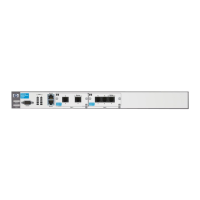10-6
Bridging—Transmitting Non-IP Traffic or Merging Two Networks
Configuring Bridging
To configure bridging, you must:
■ configure a bridge group
■ assign interfaces to the bridge group
■ disable IP routing, if you are bridging IP traffic
Note The ProCurve Secure Router does not both route and bridge IP traffic. If you
want to bridge IP traffic, you must disable IP routing.
However, the router can route IP traffic and bridge non-IP traffic at the same
time. It can even route IP traffic and bridge non-traffic IP traffic on the same
Frame Relay or ATM interface. For example, you could configure Frame Relay
subinterface 1.101 as part of a bridge group for non-IP traffic, but route IP
traffic through Frame Relay subinterface 1.102.
Configuring a Bridge Group
You create bridge groups from the global configuration mode context. When you
create the bridge, you must specify that it uses IEEE:
Syntax: bridge <group number> protocol ieee
The group number can be between 1 and 255. For example:
ProCurve(config)# bridge 1 protocol ieee
Assigning an Interface to the Bridge
You configure bridging on Data Link Layer interfaces. Typically, you will assign
both LAN and WAN interfaces to the bridge group.
LAN interfaces include:
■ Ethernet interfaces
When you enable 802.1Q encapsulation on an Ethernet interface, you can no
longer assign it to a bridge group; the interface can now carry traffic for
multiple VLANs and you cannot bridge traffic between different VLANs.
WAN interfaces on which you can configure bridging include:
■ PPP interfaces
■ High-level Data Link Control (HDLC) interfaces
■ Frame Relay subinterfaces
■ Asynchronous Transfer Mode (ATM) subinterfaces

